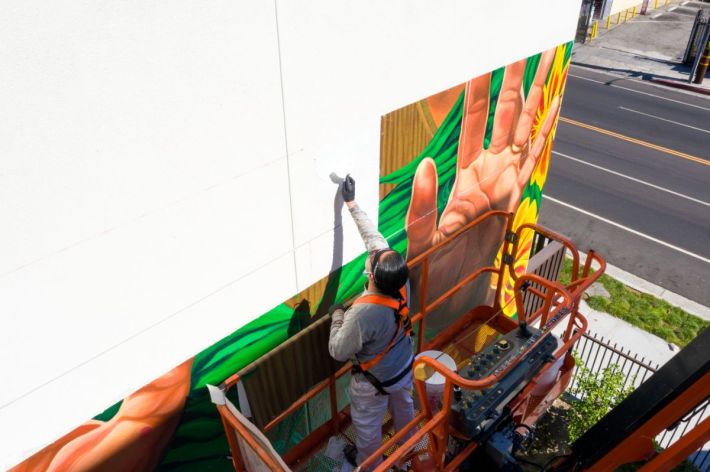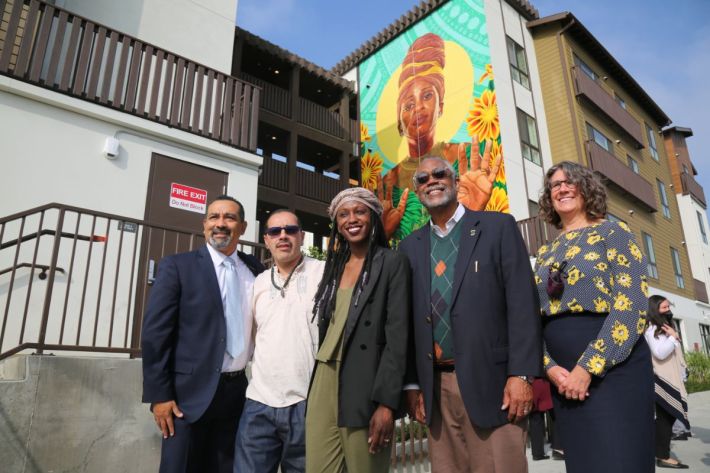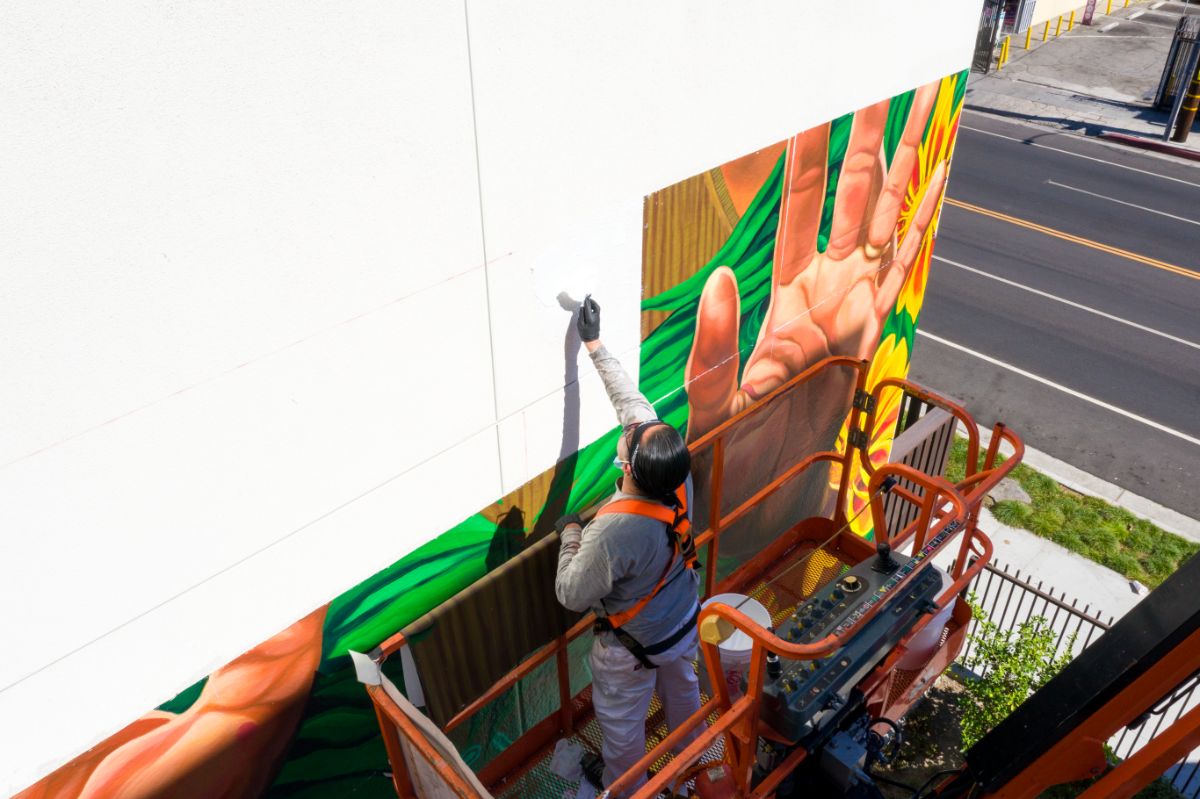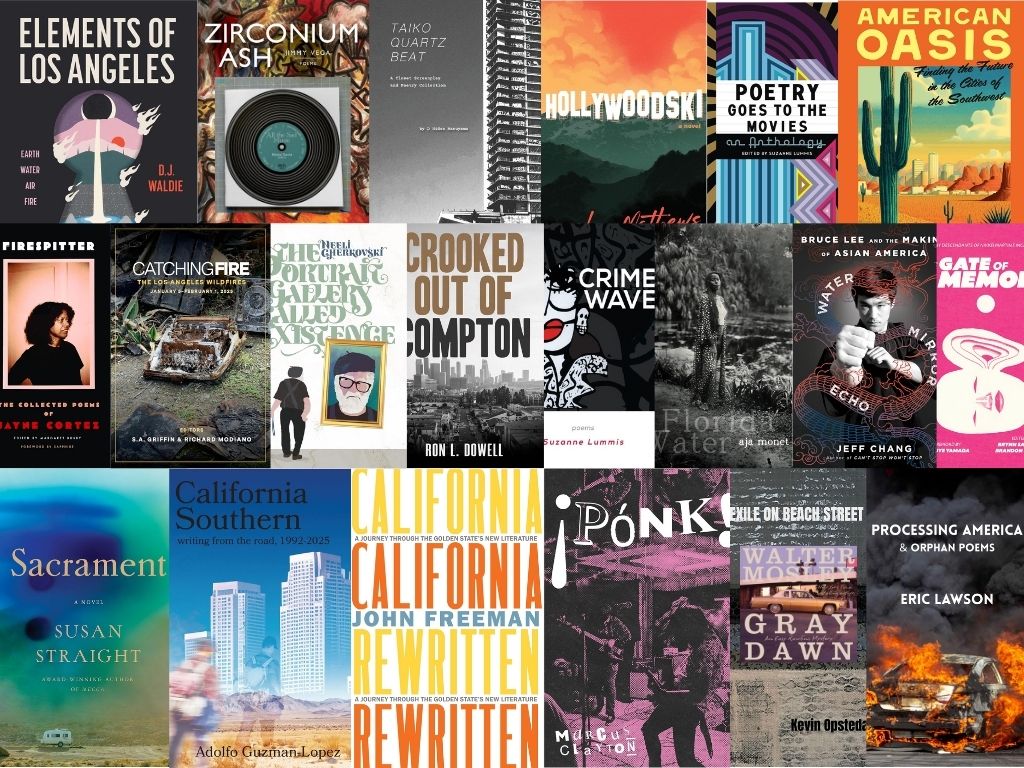This poem is for the forgotten.
for the people who live by and die by the root.
or the ancestor push.
or the pen. or the block.
or the bullhorn.
This poem is for the city stoop.
Award-winning poet Alyesha Wise recited these words from her piece, “For us, the Congregation,” in an inauguration ceremony on November 17, 2021, in a garden courtyard directly below a mural of herself. The inspiring event commemorated the completion of two technicolor murals painted by the prolific artist Fabian Debora. Located at 69th and Main Streets in South Los Angeles, the murals feature Wise and the equally illustrious poet Felicia Montes on the front facade of a new apartment complex that offers permanent housing for formerly homeless families.
Officially titled “In Lak'Ech: You Are My Other Me,” this particular commission is extra significant to Debora because it celebrates women leaders, promotes Black and Brown unity, and encourages the dreams of local youth all in one large piece in a new complex built for low-income residents. In the same way, Wise’s poem remembers the forgotten ones, Debora paints for them, and he’s spent a lifetime walking the walk. “I make sure my art corresponds to the community that it resides in,” he states.


Besides being a celebrated artist, Debora is the Founder and Executive Director of the Homeboy Art Academy. He grew up in the Pico Aliso Housing Project in Boyle Heights, and he once belonged to one of the most notorious gangs in the area. He is a survivor of the era Father Greg Boyle calls “the Decade of Death: 1988 to 1998.” He remembers where he came from and uses his past to create art that promotes healing and positive self-identity for the community.
I Am the Artist That Walks With the People
We Black & We Brown
We broke, but we proud,
Say it loud!
—“Cadillac”
This short song-poem was sung daily to Debora as he finished the two murals over a 10-day period by “Cadillac,” an elder African-American street character and lifelong South Central Los Angeles resident. Cadillac came by every day while Debora installed the murals, and they always shared words and a few laughs.
“I am the artist that walks amongst the people,” Debora says. Everywhere he goes, he communes with the people, whether it’s Cadillac pedaling up on his bicycle or the dozens of school-age children walking by praising his work. Debora remembers them all, and he believes murals are a portal into a better world. “Art can make people or break people,” Debora says. “It all depends on how you use it. I use art to make people.”
This mural project is Debora’s most significant milestone yet because the intersection of beauty and more profound meaning converge here on so many levels. Debora always uses real people as the basis for his murals, and he believes that by painting these larger-than-life images of local greats, he can play his part in painting a better future to inspire his viewers.
The title of the mural, “In Lak’Ech: You Are My Other Me,” resonates on so many levels. First, the phrase, “In Lak’Ech,” is an important Mayan concept which essentially translates into “You are my other me.” The two powerful women mirroring one another and standing across from each other over the courtyard embody this concept and make a powerful statement to everyone in the neighborhood.
On the morning of the mural’s inauguration, Debora said, “we are bigger than ourselves.” A few dozen of his students from the Homeboy Art Academy cheered loudly in the crowd as he reflected on his process. The large, brightly colored murals of Felicia Montes and Alyesha Wise demonstrate Debora’s commitment to the community, his students, and walking with the people.
Standing just over 32 feet tall on the south wall facing north, Felicia Montes is a Xicana Indigenous artist, activist, community organizer, educator, poet, performer, professor, and healing arts practitioner. Montes is the founding director of Mujeres de Maiz, and she has also been a part of a collective of women poets, dancers, and drummers called “In Lak’Ech.” Debora selected Montes because she has always inspired him with her powerful presentations and all the incredible work she does empowering youth, especially young women across the city.
On the north wall, equally tall facing south, is the similarly prolific Alyesha Wise. Ms. Wise is a well-revered poet and teaching artist who is a co-founder of the Spoken Literature Art Movement (S.L.A.M.). Wise has also worked with the well-respected Los Angeles organization Street Poets, and several of her students and colleagues were on hand at the inauguration cheering her on. Francisco Escamilla, aka the Busstop Prophet who works with Wise at Street Poets, declares: “Alyesha Wise is a powerful and transcendent voice in poetry, in a time in our culture where poetry can change the world. She is a passionate teaching artist who genuinely wants to help young people find and use their voice.”
You Are My Other Me
The title of the mural, “In Lak’Ech: You Are My Other Me,” resonates on so many levels. First, the phrase, “In Lak’Ech,” is an important Mayan concept which essentially translates into “You are my other me.” The two powerful women mirroring one another and standing across from each other over the courtyard embody this concept and make a powerful statement to everyone in the neighborhood. His compassion matches Debora’s artistic talent, and he’s using this mural to remind everyone that “you are my other me.”
This idea is especially true in the case of Felicia Montes and Alyesha Wise. You’d be hard-pressed to find two other poet-activist-educators anywhere in America as committed and talented as either one. “Sisterhood is powerful,” Montes exclaimed on Instagram when she posted the mural photos.
Both women have open hands extending out near the lower half of their respective pieces because they are here to help the community. They also have their hands in front of them as mirrors to one another and share energy between their hands as a prayer. This also ties into another critical idea for Debora from the African philosophy of Ubuntu which states, “I am because we are.”
Debora painted them in this larger-than-life stature so that the legions of young Black and Brown youth who live in the immediate area can see a future version of themselves and have daily inspiration. Besides the dozens of children who live in the building, hundreds of kids walk by every day because Bethune Middle School is one block directly north.


On one of the final days of the installation, a 10-year-old girl walking by Debora on the building’s balcony pointed at the mural of Alyesha Wise and said to him enthusiastically, “That’s me, that’s me on that wall! That’s beautiful.” Debora told her, “yes, it is.”
She radiated confidence and an uplifting spirit that made Debora’s day. This moment confirmed his intention and let him know his gut instinct of painting these two iconic women in this location was a breakthrough move.
The murals begin on the facade about 12 feet up and tower over the garden in majesty. A few tangerine and lemon trees, cabbage, and a sunflower grow just below. Both women stand tall on their respective walls framed within a rectangular shape close to 20 feet wide. Debora painted both of these murals at his studio in Boyle Heights on vinyl and attached them at the site in three by three-foot squares.
The whole project was close to a year in the making, and the on-site installation process after he finished the work in his studio took about ten days in late October. Debora installed the mural on the building’s walls using an 86-foot boom lift. I came by the location four times over a week and a half and watched the entire process from start to finish.
Painting A New Neighborhood History
Until a generation ago, this area of Historic South Central along Main Street, just north of Florence and Watts and adjacent to Florence Firestone, was a predominantly African American district, but now it is equally Black and Latino. Going back even further until 1948, Main was the western boundary of the restrictive housing covenants that kept African Americans boxed into South Central Los Angeles. Cadillac told Debora that he’s been in the area since the 1950s.
“I recognize,” Debora says, “That this community at one point was fractured, and it may still have a few scars. I do realize that there may be residue of Black and Brown conflict. Although I see things otherwise, I intend to offer an image of two sacred women who are offering safety, protection, and a nurturing spirit for the residents here.” Debora painted Felicia and Alyesha here as a blessing, a visual prayer for the neighborhood. A line from Alyesha Wise’s poem applies here: “This poem is for your living mural.”
The building, “Residences on Main,” is a 50-unit location dedicated to supportive housing for homeless families and transitional age youth.
On the morning of the mural’s inauguration, just before Wise recited her poem, Councilman Curren Price briefly spoke and emphasized that this mural and new building are “rewriting neighborhood history.” Alejandro Martinez, the President of the nonprofit organization, the Coalition for Responsible Community Development (CRCD)---the owners of the building---also spoke, and he mentioned how in 2010, there used to be a building on this same site that was a nuisance property rife with illicit activity.
Martinez and his organization are determined to offer hope and transformation with their buildings. They are one of the only developers in the city not building luxury condos or high-end apartments. Martinez takes pride in the fact that they build neighborhoods responsibly by building quality units for low-income residents. CRCD partnered up with L.A. Family Housing on this project. These groups have lengthy track records reinvesting in the community with quality complexes. Committed to “building a better tomorrow,” they chose Debora to paint these murals because his work does this also.
The building, “Residences on Main,” is a 50-unit location dedicated to supportive housing for homeless families and transitional age youth. It is one of CRCD’s latest sites. CRCD’s mission, according to their Communication Coordinator, Jennie Hernandez, “is to better sustain, coordinate and improve local planning, development and community services that address the needs of low-income and working-class residents and small businesses in South Los Angeles.” Their vision “is to join with others in the community to create an environment where the basic needs of youth are met; where youth can develop positive social skills, become more aware of their neighborhood’s needs, and demonstrate genuine civic pride by actively contributing to the empowerment of their community.”
Their mission aligns perfectly with Debora’s. As an artist, advocate, educator, and healer, Debora worked for many years as a substance abuse counselor at Homeboy Industries. Hence, he takes the idea of healing and uplifting community members very seriously.
The first morning of the installation was a cloudy Friday. I watched Debora sit perched on the boom lift almost 50 feet up in the air over the courtyard. Using a metal yardstick, Debora marked where he would mount his vinyl mural on the north wall. He’s marking off three-foot intervals. An exercise in geometry, Debora meticulously measured each square.

of LA Family Housing. Photo by Dario Debora.
Debora had a steady stream of observers watching the installation process unfold, including residents in the building, his younger brother Dario, mentees from Homeboy Industries like the MC, Jojo and close friends like Obed Silva, a fellow painter, author, and English Professor from East Los Angeles College and Homeboy Industries.
“Fabian Debora,” Silva states, “is a man who’s full of life and who gives back to the community every day, whether by picking up a brush and painting the lives of those who would otherwise be overlooked or by opening up the doors of his studio to give free art lessons to the next generation of East Los and Boyle Heights artists.”
When he began as a street artist, he was called SPADE. The acronym stands for “Spirits Prosper As Dimensions Exposed.” At 17, Debora met the East Los Streetscapers, Wayne Healy and David Botello, and they taught him the responsibility of art, cultural knowledge, and giving back to the community. These core values are especially relevant to him now. He remembers they taught him how to look within and to “paint what you see, paint what you feel.”
The Power of Extravagant Tenderness
Debora is the Founder/Executive Director of the Somos LA Arte/Homeboy Art Academy, an organization connected with Homeboy Industries that he started in 2008. Their mission is to “foster leadership through cultural knowledge, artistic expression, and community inclusion.” Debora had known Father Greg Boyle since 1986 when the artist was a 10-year-old boy living in the Pico Aliso Housing Project.
Debora was just selected to do a mural on a building being built at First and Lorena, a few blocks from his studio close to where Boyle Heights transitions into East Los Angeles. This mural will not only celebrate the multicultural history of Boyle Heights, but Debora also plans to highlight the Tongva history in Boyle Heights, which he feels is often overlooked in the many discussions and murals around the iconic neighborhood.
There was a transformative moment in Debora’s life during middle school where a teacher threw away one of his drawings, and this led Debora to throw a desk across the room. Father Boyle heard about this and asked Debora to draw the Priest something and bring it back the next day. This compassionate act cemented his bond with Boyle and affirmed the young artist's belief in the transformative power of art. What’s more is that the compassion Boyle gave to Debora is the same compassion Debora now shares in his art, with his students, and in everything he does. Debora’s done the cover art for Boyle’s books, including the recently published, The Whole Language.
In 2007, when Debora got sober and went into rehab, he reunited with Boyle. After he came out of rehab, he dove deep into his art and also became a substance abuse counselor for Homeboy Industries and then started Homeboy Art Academy. Debora has now done for others what Boyle did for him by offering hope and showing a pathway forward through the lens of art. The subtitle of Boyle’s new book, “The Power of Extravagant Tenderness,” applies here too.
Former Los Angeles Poet Laureate and best-selling author Luis Rodriguez has known Debora for over 25 years. Rodriguez recently told me, “I love Fabian’s work. We met in Rome for the largest Hip Hop gathering in the world at the time: graffiti, b-dancing, MCing, DJing, and Unity. Fabian is a true master.” Rodriguez wrote about Debora and their first encounter in his last book, From Our Land to Our Land. Debora painted a mural in Rome that included Rodriguez’s poem, “City of Angels.” They have continued to collaborate, and Debora’s work even graces the cover of one of Rodriguez’s books.
Debora was just selected to do a mural on a building being built at First and Lorena, a few blocks from his studio close to where Boyle Heights transitions into East Los Angeles. This mural will not only celebrate the multicultural history of Boyle Heights, but Debora also plans to highlight the Tongva history in Boyle Heights, which he feels is often overlooked in the many discussions and murals around the iconic neighborhood.
Driven by a desire to uplift his community and help people heal, Fabian Debora is a man on a mission that knows we are bigger than ourselves. Debora also knows what it’s like to struggle, and he knows how to rise up and turn a life around. His personality emanates compassion, understanding, and acceptance. He has an all-knowing essence that could only come from life experience. This wisdom manifests in his art and the words he speaks. He knows we are all interconnected and always remembers that “You are my other me.”







